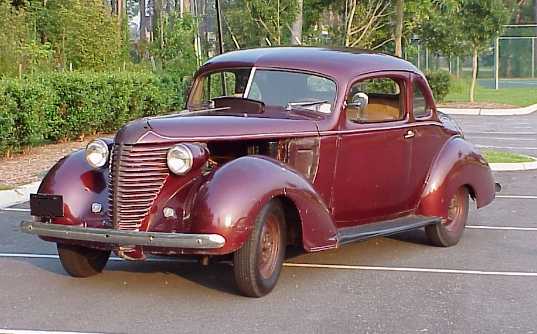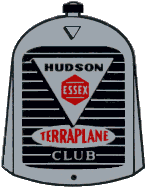|
History of Hudson Motors
On July 3, 1909 the first Hudson model "20" rolled off the assembly line in Detroit, Michigan. The car bore the name of its new manufacturer's primary financial backer, J. L. Hudson -- founder of the department store empire that still exists to this day as Dayton-Hudson. The first Hudsons were, like most early makes, "assembled cars". Most components (including engines) were purchased from outside suppliers and simply "assembled" in the company's main factory. As the years passed, however, Hudson made an ever-increasing percentage of its own components "in-house": engines, bodies (when even GM and Ford "subbed out" their bodies), transmissions and differentials, to name but a few.
In 1910 Hudson introduced one of its hallmarks, the fluid clutch. A bath of oil, or "Hudsonite" as it later became known, provided smooth engagement between the clutch plate and a disc containing hundreds of small round cork inserts. All manual transmissions used this wet clutch with the exception of the Jet and the Metropolitan which both had a dry clutch. The wet clutch remained unique to Hudson through 1954.
In 1916 Hudson manufactured its first engine, the "Super Six". It was the auto industry's first inherently-balanced, modern, high compression L-head motor, and it was vastly more powerful and lighter than the one previously supplied to Hudson by the Continental Motor Company. Throughout the years, "Super Six" would continue as a familiar Hudson moniker, even though the engines bearing that name were continually modernized and redesigned.
The Essex automobile appeared in 1919. This was a lighter and less-expensive Hudson, designed to compete in the lower price range, just above the level of Ford and Chevrolet. In 1922, when open cars were still the norm, Essex introduced its coach, the first mass-produced, competitively-priced closed car. GM's Alfred P. Sloan called this an event that profoundly influenced General Motors and Ford.
By 1929, Hudson and Essex bodies were almost completely made of steel -- at a time when most competitors still tacked metal panels to a wooden frame. In that year, the Hudson Motor Car Company moved to third place in sales, just behind General Motors and Ford. The coming economic depression would be a disaster for Hudson and the entire automotive industry.
Hudson introduced the Essex Terraplane in 1932. Designed to compete for scarce Depression-era dollars, the Terraplane was a small but powerful car, built to Hudson's exacting standards. Essex and Hudson models were also built that year, but by 1933 the Essex nameplate was history. Terraplanes would grow in size throughout the 1930's until they were barely-distinguishable from standard Hudsons by 1938, the marque's last year. In 1939 the inexpensive Hudson was called the "112".
For most years from 1926 to 1947 Hudson produced light pickup trucks and "commercial vehicles" under various names, depending on the year: Essex, Dover, Terraplane and (after 1938) Hudson. Other specialty cars offered by Hudson in the 1930's and 1940's included panel deliveries, "woody" wagons, coupes with slide-out pickup beds in the trunk -- even a "stand-up" delivery van! Ambulances, hearses and limousines were also produced on Hudson chassis by outside body companies.
During World War II all US auto production was halted and every car company produced armaments. From the Hudson factories flowed aircraft wings and fuselages, Oerlikeon anti-aircraft guns, and mammoth "Invader" landing craft engines. As the war ended Hudson, like other US auto manufacturers, returned to car production offering versions of their pre-war 1942 models, all that was necessary to satisfy a car-hungry public.
In 1948 Hudson introduced the strikingly advanced "Step-Down" models with streamlined "Monobuilt" unit-bodies. Passengers "stepped down" into their seats, located within the car's massive perimeter frame rails (a safety feature). A lower center of gravity and wider bodies enabled full six-passenger seating. Buyers could choose between a new 262 cubic-inch six cylinder engine or the old reliable straight eight. Pent-up postwar demand helped boost sales to over 100,000 for the first time since 1929.
In 1951 "Hornet" was born -- a "hot" version of the Step-Down series. The 6-cylinder engine was enlarged to 308 cubic inches and 145 horsepower. Later in the year, "Twin H-Power" dual carbs upped horsepower to 155. In 1952, Hudson introduced the 210-horsepower "7-X" racing engine. Stock car racing drivers liked Hudson's power, cornering ability and low center of gravity. From 1951 through 1954 Hornets dominated championships in NASCAR, AAA (later USAC), IMCA, and Pacific West Coast Racing -- the "Hornet Hey-Day", according to Speed Age Magazine.
Hudson introduced the Jet and the Italia in 1953. The Jet, built in 1953-54, was an early "compact car." Despite its excellent quality of construction, its styling was mediocre, and sales were disappointing. The Italia was a limited-production "dream car" with a hand-made body built in Italy on the Jet chassis. Twenty-seven were built in 1953-54; most survive.
The end of the postwar sales boom and increasing competition from the "Big Three" was hard on the seven remaining "independent" auto companies. Hudson merged with long-time rival Nash in 1954 to form American Motors (which survived until the mid-1980's). The 1955 Hudsons shared bodies with Nash at its Kenosha, Wisconsin factory; the Jet and Italia were dropped. As AMC's Rambler grew in sales, Nash and Hudson sales declined, and those nameplates passed into history at the end of the 1957 model year.
|
|


